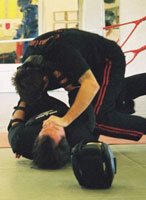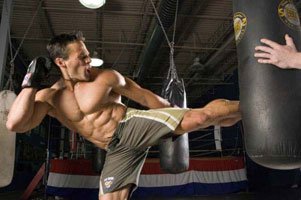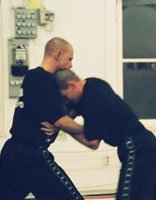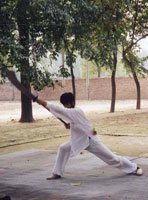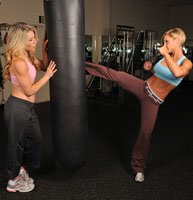
TOPIC: What Is The Best Martial Arts Workout?

The Question:
With instructional DVDs, trainers and gyms available, many people have taken up martial arts as their primary workout.
What is the best martial arts workout?
What are some of the benefits to a martial arts workout?
How does a martial arts workout compare to a standard strength and conditioning workout?
Show off your knowledge to the world!
The Winners:
- soundcheck129 View Profile
- wtfmate08 View Profile
Prizes:
- 1st place - 75 in store credit.
- 2nd place - 50 in store credit.

1st Place - soundcheck129
View This Author's BodySpace Here.

With instructional DVDs, trainers and gyms available, many people have taken up martial arts as their primary workout.
Martial arts has seen a surge in popularity in recent years, with many finding an appreciation for the strength and skill required to master this ancient art of combat.
While muscular strength and endurance are helpful, agility, balance and explosive power also play key roles, so training sessions can be quite different than the standard bodybuilding workout. Because hand-to-hand combat is so demanding, workouts combine many different types of training into often exhaustive sessions.

What Is The Best Martial Arts Workout?
Martial arts workouts do share one thing in common with bodybuilding workouts, though - warming up is essential. A proper warm-up will get the blood flowing, get your muscles ready for action, reduce the chance of injury, and get you pumped up!

Warm-Up:
- 3 Minutes Jumping Rope
- 1 Minute Rest
- 100 Jumping Jacks
- 1 Minute Rest
- 30 Walking Lunges
- Static Stretching
 Click Here For A Printable Log Of soundcheck129's Warm-Up.
Click Here For A Printable Log Of soundcheck129's Warm-Up.

Phase I - Combat
- Shadow Boxing: 2 minutes on, 30 second break, 2 minutes on
- Heavy Bag Work: 10 minutes (working on jabs and kicks)
- Sparring With Partner: 15 minutes
 Click Here For A Printable Log Of soundcheck129's Phase I Workout.
Click Here For A Printable Log Of soundcheck129's Phase I Workout.

Phase II - Explosive Strength
Strength Circuit:
- 25 Bodyweight Squats
- 25 Diamond Push-Ups
- 25 Bicycles
- 20 Burpees
- 25 Russian Twists
 Click Here For A Printable Log Of soundcheck129's Phase II Workout.
Click Here For A Printable Log Of soundcheck129's Phase II Workout.
- After this circuit, you may want to perform some lifts, such as:
- Bench Press
- Power Clean
- Weighted Crunches
- Barbell Row
- Deadlifts
If you don't have weights available, repeat the circuit, with one minute of rest between circuits.
On off-days, you may want to perform the Strength Circuit at home twice per day and perhaps do some cycling or HIIT running. This will aid your conditioning and keep your cardiovascular fitness at a high level for combat.

What Are Some Of The Benefits To A Martial Arts Workout?
The benefits of martial arts are practically limitless. Similar to other weight lifting routines, martial arts increases strength and contributes to the development of lean mass. Martial arts can help one who is trying to bulk up or slim down.
Unlike lifting for strictly bodybuilding purposes, martial arts training has a significant focus on conditioning, endurance and agility. This makes martial arts training an excellent way to stay in shape during the off-season for sports or just to improve one for any athletic pursuit.
| BODYBUILDING.COM FORUM: AGILITY/ENDURANCE | |||
|
Started By: Shwayze |
Martial arts training is more than just physical. Martial arts involves many different techniques that need to be learned, which stimulates the fighter's mind. Proper execution of moves and form requires discipline and hard work, which is helpful in other areas of life, too.
The confidence that comes with achievement in combat is a powerful tool that will aid you in many situations, and so will the respect you will have for, and earned from, your fellow trainees. Mastering your body and martial arts provides a substantial amount of pride.
Last but not least comes the benefit of knowing that you will be able to defend yourself and your loved ones if ever the need arises. Quick thinking and being able to fight without any weapon will serve you well if you live in a dangerous area or become the target of harassment or violence.

How Does This Compare To A Standard Strength And Conditioning Workout?
While martial arts workouts are generally not as conducive to hypertrophy as standard strength-building routines, the ability to build strength is there. Martial arts workouts will benefit explosive strength and muscular endurance, which is required to keep battling in the late rounds of a fight.
There is also a more pronounced focus on cardiovascular conditioning, agility and speed, because one must be able to react quickly and keep an opponent at bay. Usually, traditional weight-lifting routines do not incorporate these factors. Additionally, martial arts helps you build a very strong core.
Martial arts also places a lot of value on proper form and technique, which means it may stimulate your mind more than the traditional weight-lifting session. There is a lot of decision-making involved in defending oneself and anticipating the moves of others.
Because of all of these elements, martial arts workouts are very demanding. So like traditional strength training, martial arts work requires proper rest and nutrition in order to guarantee success.

2nd Place - wtfmate08
View This Author's BodySpace Here.

First let me say I am going to do this under the assumption you mean an "all martial arts workout," with no weightlifting, as the title does not specify weight lifting program.

What Is The Best Martial Arts Workout?
Counting boxing as a martial art (which it sort of is, because it is being included in almost every MMA program these days) I would have to say a combination of Kickboxing, Muay Thai, and Boxing.
 |
What Is Muay Thai? Muay Thai, or Thai Boxing, is a form of hard martial art practiced in large parts of the world, including Thailand and other Southeast Asian countries. The art is similar to others in Southeast Asia such as: pradal serey in Cambodia, lethwei in Myanmar, tomoi in Malaysia, and Lao boxing in Laos. Muay Thai has a long history in Thailand and is the country's national sport. Traditional Muay Thai practiced today varies significantly from the ancient art muay boran and uses kicks and punches in a ring with gloves similar to those used in Western boxing. Muay Thai is referred to as "The Art of Eight Limbs", as the hands, shins, elbows, and knees are all used extensively in this art. A practitioner of Muay Thai ("nak muay") thus has the ability to execute strikes using eight "points of contact," as opposed to "two points" (fists) in Western boxing and "four points" (fists, feet) used in the primarily sport-oriented forms of martial arts. |
 |
 |
||
Kickboxing, Muay Thai, and Boxing are second to none in giving you the best muscular endurance for your upper body, most specifically your shoulders. If you don't believe me, try throwing nonstop punches to a Heavy Bag for 5 minutes and let me know how you do.
Kickboxing and Muay Thai, and Boxing will also help in developing an incredible core, as all of your power comes from it during your strikes. You also get added strength AND mass in your neck due to resisting a Muay Thai Plum or clinch. Your neck will probably be miserable the next day after practicing pummeling with someone, but will soon adapt to the stress. After all, I believe the next is the most underdeveloped part of bodybuilders/athletes.
Here is a routine I would do to incorporate all three:
- 5-10 minutes of
- 10 minutes of pummeling with a partner (working the Muay Thai clinch)
- 15 minutes of pad work for Kickboxing/Muay Thai (basically just Kickboxing but add in knees and clinch-work as well)
 |
What Is The Muay Thai Clinch? In Western Boxing the two fighters are separated when they clinch; in Muay Thai, however, they are not. It is often in the clinch where knee and elbow techniques are used. The front clinch should be performed with the palm of one hand on the back of the other. There are three reasons why the fingers must not be intertwined. 1) In the ring fighters are wearing boxing gloves and cannot intertwine their fingers. 2) The Thai front clinch involves pressing the head of the opponent downwards, which is easier if the hands are locked behind the back of the head instead of behind the neck. Furthermore the arms should be putting as much pressure on the neck as possible. 3) A fighter may incur an injury to one or more fingers if they are intertwined, and it becomes more difficult to release the grip in order to quickly elbow the opponent's head. A correct clinch also involves the fighter's forearms pressing against the opponent's collar bone while the hands are around the opponent's head rather than the opponent's neck. The general way to get out of a clinch is to push the opponent's head backwards or elbow him or her, as the clinch requires both participants to be very close to one another. Additionally, the non-dominant clincher can try to "swim" his or her arm underneath and inside the opponent's clinch, establishing the previously non-dominant clincher as the dominant clincher. |
 |
 |
||
After the 15 minutes, end with "54321s." What this is just a nonstop, finishing drill for your kicks. Say you start with your right leg. Kick a pad 5 times IN A ROW. Then pause for 1 second to reset yourself. Not to rest, just to reset. Then do 4 times. Continue until you finish with 1, then change sides.
15 minutes of Boxing pad work (main difference between this and the kickboxing/Muay Thai, besides no kicks/knees, is that you work your footwork, which is one of the most important things in a boxers arsenal and will also help with your cardio).
To finish it off, do the following circuit 5 times (if you can):
- 40 Crunches
- 10 Burpees
- 5 Pullups
 Click Here For A Printable Log Of wtfmate08's Training Circuit.
Click Here For A Printable Log Of wtfmate08's Training Circuit.

What Are Some Of The Benefits To A Martial Arts Workout?
As I mentioned before, you will have muscular endurance (ESPECIALLY in the shoulders) that is second to none. This is also very much a fat burning workout. I don't care what you look like when you start, after a few months of this you will look more toned than you ever have, with the cardio to go along with it!
Also, you get the added benefit of learning self-defense so you can feel better if you are in a city late at night, etc.

How Does This Compare To A Standard Strength And Conditioning Workout?
I wouldn't really compare it to a strength workout. The only strength you will gain is in the neck, in which case I would say martial arts is the best exercise/way to build a good neck (just by practicing the Muay Thai clinch). To be honest, you won't gain a lot of strength otherwise. BUT, you will be in absolutely amazing condition, as it takes your whole body to throw punches, kicks, and knees.

